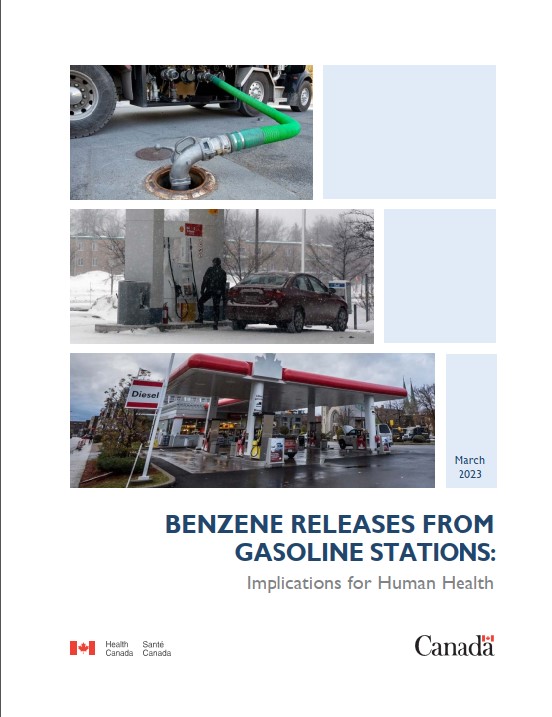Benzene releases from gasoline stations - Implications for human health: Overview
On this page
Synopsis
Benzene is a recognized human carcinogen and, as such, a component in gasoline of particular concern. The objective of this assessment is to estimate the contribution of benzene emissions to inhalation exposures for communities residing in proximity to gasoline stations.
Two emission pathways are considered:
- long-term continuous benzene emissions via evaporative losses from gasoline station operations and
- short-term benzene emissions during tanker truck fuel unloading
Air dispersion modelling was used to estimate annual average benzene concentrations attributable to gasoline station emissions for varying distances from the gasoline station fenceline. Specific scenarios assessed include gasoline stations with baseline, median and high yearly gasoline throughputs. Air dispersion modelling was also used to estimate the average benzene concentrations at different distances from the gasoline station fenceline during the 1-hour time of average-sized tanker truck unloading, assuming the absence of vapour recovery and vent valves. For both types of releases, it is concluded that the inhalation exposures to benzene attributable to gasoline station emissions may pose unacceptable risks to human health for the general population living in the vicinity.
There are methods to reduce benzene exposures and human health risks associated with benzene emissions from gasoline stations. These include vapour recovery, the use of pressure/vacuum (p/v) valves on vent stacks at gasoline stations and the implementation of minimum setback distances for new construction. These could contribute to a decrease in benzene exposure for the general population in Canada, including potentially vulnerable populations such as pregnant people, fetuses and children.
Introduction
Benzene is recognized as a human carcinogen by Health Canada (Canada 1993) and the International Agency for Research on Cancer (IARC) (IARC 2018). In Canada, the Benzene in Gasoline Regulations under the Canadian Environmental Protection Act 1999 (CEPA 1999) allow gasoline from a production facility to contain up to a maximum of 1.5% volume/volume (v/v) benzene, but require that the benzene content in gasoline from any production facility have an annual average of no more than 0.95% v/v (Canada 1999b; Canada 1997). Surveys of gasoline composition based on over 2,500 samples annually (2013–2019) from 25 manufacturing, blending and importing facilities determined that, over this time and over all regions of Canada, these targets were met, with the overall average benzene concentration in gasoline being 0.6% v/v, and only 3% of facilities reporting individual samples with benzene concentrations ranging between 1% and 1.5% (ECCC 2021).
Internationally, other jurisdictions have enacted similar regulations to limit the benzene concentration in gasoline. Refiners and importers in the United States are limited to a maximum annual average benzene content in gasoline of 0.62% v/v (US EPA 2012). European Union regulations permit up to 1% benzene in gasoline (European Commission 2000).
Gasoline stations are commonly located in close proximity to residential areas and the routine operations of gasoline stations can lead to the release of benzene in gasoline vapour resulting in potential exposures for the general public. Indoor and outdoor air levels of benzene are higher near sources of emissions such as filling stations (WHO 2000). These releases are from day-to-day evaporative losses during the operation of the gasoline station, as well as intermittent gasoline vapour releases during filling of underground storage tanks.
The mean concentration of benzene in ambient air in 16 Canadian cities surveyed between 1999 and 2009 was 0.3 to 2.9 µg/m3 (Health Canada 2013). Measurements of outdoor benzene concentrations in Canada from 1999 to 2019 (with a minimum of 40 valid sampling points at each site) showed a downward trend (NAPS 2019). In 2019, annual average rural and urban benzene concentrations were 0.20 and 0.44 µg/m3, respectively. Airborne concentrations of benzene at the perimeter of gasoline stations in 5 Canadian cities averaged 439 µg/m3 in the summer of 1985 (PACE 1987) and 1,383 µg/m3 in the winter of 1986 (PACE 1989). No recent Canadian studies of benzene concentrations in the vicinity of gasoline stations have been identified.
A number of more recent studies reported benzene concentrations in the vicinity of gasoline stations in the United States and Europe (Palmgren 2000; Hilpert 2015, 2019; Barros et al. 2019; Hsieh 2021). These studies have raised concerns regarding potential elevated exposures to benzene for the general population living near gasoline stations. Specifically, concerns were expressed regarding the setback distances of residences with respect to gasoline stations, the effectiveness of vapour control measures and the total volume of gasoline dispensed near residential areas (Hilpert 2015, 2019; Hsieh 2021).
There is a wide range of potential sources of benzene exposures for Canadians (for example, consumer products, building materials, industrial releases and smoking) in both indoor and outdoor air (WHO 2000). The objective of this assessment is to estimate the contribution of emissions from gasoline stations to benzene inhalation exposures for individuals residing in proximity to gasoline stations in Canada. Two emission pathways are considered:
- long-term continuous benzene emissions released via evaporative losses from gasoline stations
- short-term benzene emissions released during tanker truck fuel unloading
While it is noted that some jurisdictions in Canada mandate vapour recovery during tanker truck fuel unloading at gasoline stations (for instance, Stage 1 vapour recovery (CCME 1991), refer to the section on mitigating measures), this report estimates potential benzene inhalation exposures from gasoline station emissions via air dispersion modelling in the absence of vapour recovery during fuel unloading to identify potential risks to human health following these exposures.
This assessment was undertaken to provide Canadian jurisdictions, regulators and policymakers with an evaluation of the potential magnitude of benzene vapour emissions from gasoline stations and the associated health risks. This report is intended to be used to inform decisions regarding mitigation of benzene vapour emissions from gasoline stations and health impacts associated with this benzene source in Canada.
